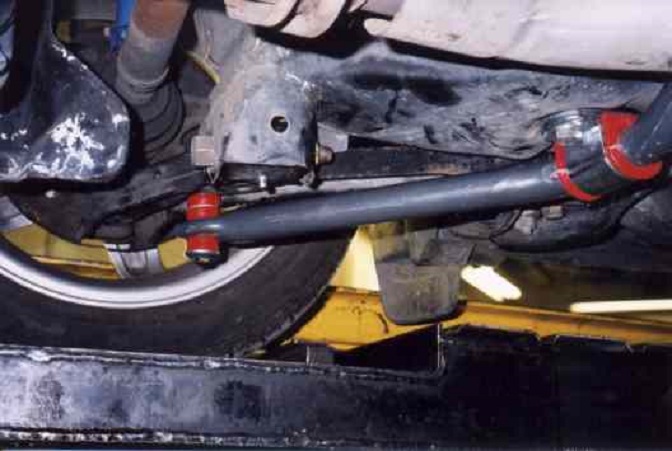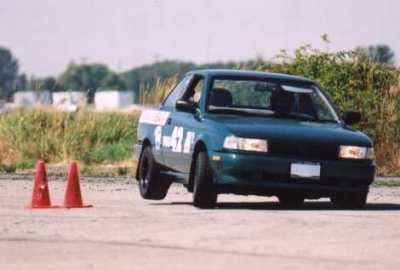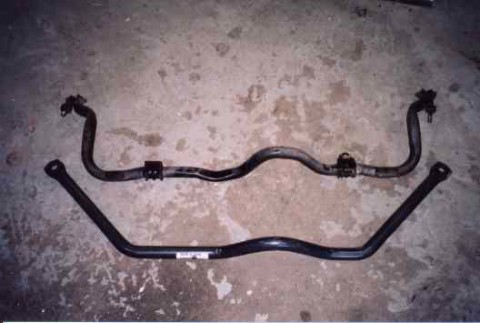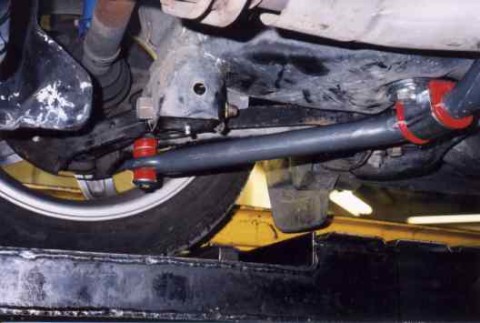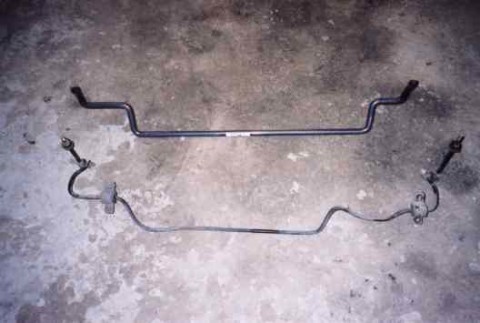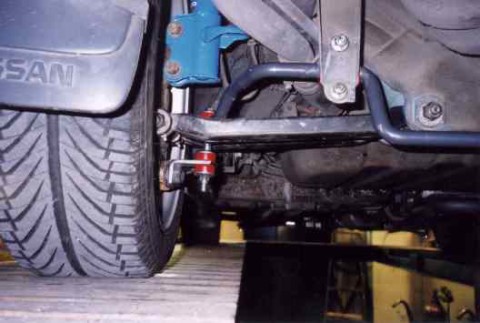[ Start ] [ Wheels & Tires ] [Bushings ] [ Springs & Struts ] [ Sway Bars ] [ Alignment ] [ Drivetrain ] [ Miscellaneous ] [ Racing ]
Description
Sway bars improve the handling of the vehicle by limiting the amount of body roll induced in a turn. This is accomplished by linking both sides of the suspension together with a U-shaped bar of spring steel. When the outside undergoes compression, the bar lifts the inside wheel, which levels the car and thus counteracting the “roll.”
Handling can be altered by adding a sway bar to one or both ends of the vehicle. Typically, on a FWD car, a sway bar is added to the rear of a vehicle to reduce the traction from the inside rear wheel and transfer it to the outside rear wheel. This will reduce the understeer inherent to FWD vehicles.
The front sway bar is a bit of an anomaly in a FWD car. Typically it is kept stock or removed in an effort to keep the inside wheel planted. This improved traction on corner exit. Steering response, however, quickly turns to mush. While a reduction or removal of the front sway bar can reduce understeer, adding or increasing a front bar can reduce understeer as well.
MacPherson strut cars are blessed with a non-existent camber curve. As the car rolls, the camber becomes more and more positive – not what we want. If we limit the roll, we can limit the camber change, and thus keep the tires in greater contact with the road. This can reduce understeer.
Suspension Techniques Anti-Swaybar System #52125
The Suspension Techniques kit comes with front and rear sway bars, full hardware with additional mounting plates and bolts for stock and lowered cars, and marginal instructions.
The installation, however, was very easy.
| Tools Required | |
|
|
Front Sway Bar
The front sway bar is removed by undoing the end links from the control arm, then the center brackets from the frame. The exhaust must be disconnected at the flex joint in order to weasel the bar out of the car.
The factory sway bar is hollow, and attaches to the top of the control arm via traditional end links. The Suspension Techniques bar is solid, with less bends, and mounts below the lower control arm, sandwiching a bushing between the bar and the control arm.
Assembly is merely the reverse of disassembly.
The unique end links of the sway bar produce a very stiff front end (see Addendum below).
Rear Sway Bar
The rear sway bar is removed be disconnecting the end links from the struts, then the center brackets from the frame.
The factory sway bar is tiny, and attaches to a bracket from the rear strut. The Suspension Techniques bar is much fatter, and mounts to angle brackets mounted to the trailing-arm-to-spindle-bolt (which is a royal pain to deal with once polyurethane bushings have been installed). For some reason, I had to re-drill the brackets to 9/16″ as the existing holes were too small to fit the trailing-arm bolt.
When you’re installing the rear bar, attach the end links first. This will allow you to adjust the location of the center brackets so that there is even loading on the left and right suspension.
Check that you’ve tightened everything, and you’re done! Presto! A benign-looking pedestrian sedan that can out-corner an awful lot of sporty cars!
| Manufacturers | ||
| Supplier Sentra ESentra XE, GXE, SESentra SE-R/NX2000 Suspension Techniques Progress Group Whiteline |
Front 29mm (Hollow)29mm (Hollow)28mm (Solid) 30mm 30mm Adjustable 27mm |
Rear 10mm (auto only)10mm15mm 20mm 21mm Adjustable 18mm Adjustable |
Conclusion
When the polyurethane bushings were installed, the car’s handling was finally “acceptable.” When the Tokico springs and struts were installed, the car’s handling was “neat.” When the sway bars were installed, it became “FUN” to drive! The two most significant changes made were the bushings and the bars, with the bars taking the majority of the credit for the improved handling.
The car is SO responsive, so nimble, it is truly a joy to drive! Much more fun than when I first got it, and definitely money well spent. Amazing how little needed to be done to improve the handling so dramatically!
One observation is that the car is more susceptible to road irregularities. It will follow grooves and changes in road crown, and anything else it finds in it’s path. Although not dangerous at all, it is something to note. As with everything “performance,” there is always a compromise.
Addendum (2003)
After racing the car for one and half seasons with both sway bars installed, I decided to try some changes.
I was racing a lot more on asphalt instead of concrete this year, and wanted to reduce corner-exit wheelspin and the accompanying understeer. I also wanted the car to rotate a bit more. I found the Sentra very enjoyable, but I felt the car could do a bit better.
To accomplish these goals, I replaced the Suspension Techniques front sway bar with the OEM front sway bar. This should (in theory) allow the front to roll a bit more, but allow the front to stick better since the tires were not being loaded as much, as well as improve traction out of corners since there is less “lift” applied ot the inside wheel.
Initial driving impressions were that the car was MUCH softer in ride. Disappointingly so, in my opinion. I felt that I could easily run higher front spring rates now that the ST bar was off. The ST bar made the front MUCH stiffer than was calculated. Stiffer spring rates could then improve cornering by reducing body roll and the subsequent camber change. On the other hand, the softer rates would improve transition, and slalom racing is all about transition. I’m wagering that capitalizing on transition (since there are a lot of transitions) would outweigh the gains in setup for the odd sweeper.
The car is much more responsive now, and considerably more playful. It feels as though the ST bar was a bit dicey – too much on the edge of traction, whereas the OEM bar seems a bit more forgiving. you can certainly get on the gas sooner and harder with less wheelspin (unless you drop first). The steering inputs can be a bit more abrupt and the car just follows.
On course, the car handled very very well. Extremely tossable, and (although loose), very predictable and recoverable. The back was dancing sweetly. I could man-handle the car and it would keep going.
Except for punting a cone, I was 0.2s away from a BSP Corvette, and 2s behind a multi-time hill climb champion MGB GT V8 on slicks and (huge mother-of-pearl) wings.
I would say this setup can be a handful for an inexperienced driver, but very very rewarding on course. Much much more fun than before; Two thumbs up for rear ST sway bars!

